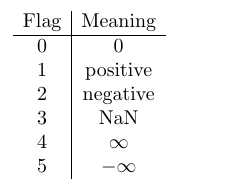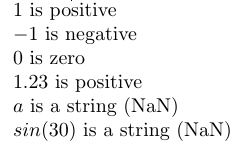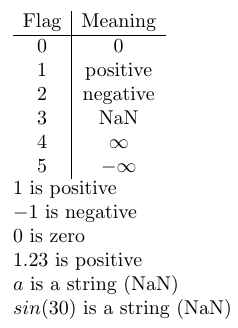|
Gibt es eigentlich von Öffne in Overleaf
\documentclass[]{article} \usepackage{tikz} \usepackage{array} \begin{document} \def\myarray{{1,0,"-1","a"}} \foreach \i in {0,...,3}{\pgfmathparse{\myarray[\i]}$\pgfmathresult$~ } \pgfmathsetmacro\t{"1"} \pgfmathparse{"\t" > 0 ? "ja" : "\t"}$\pgfmathresult$ \\ \newcolumntype{B}{ >{\bfseries}l } \begin{tabular}{B l B l } in: & \verb+\foo{a}+ & out: & $a$ ist ein String \\ in: & \verb+\foo{\frac32}+ & out: & $\frac32$ ist ein String \\ in: & \verb+\foo{-1.2}+ & out: & $-1.2$ ist negativ \\ in: & \verb+\foo{0}+ & out: & $0$ ist Null\\ in: & \verb+\foo{2}+ & out: & $2$ ist positiv \\ \end{tabular} \end{document} |
|
An sich kann man es so machen: Öffne in Overleaf
\pgfmathfloatparsenumber{123.52} \pgfmathfloattomacro{\pgfmathresult}{\F}{\M}{\E} Flag: \F; Mantissa \M; Exponent \E $\to$ \pgfmathfloattofixed{\pgfmathresult} \pgfmathresult wobei Das Kommando Öffne in Overleaf
\newcommand\foo[1]{ \pgfmathfloatparsenumber{#1} \pgfmathfloattomacro{\pgfmathresult}{\F}{\M}{\E} \pgfmathparse{\F==0 ? "$#1$ is zero" : ( \F==1 ? "$#1$ is positive" : ( \F==2 ? "$#1$ is negative" : ( \F==3 ? "$#1$ is a string (NaN)" : ( \F==4 ? "$\infty$" : ( \F==5 ? "$-\infty$" : ("I do not know" ))))))}\pgfmathresult} liefert dann Öffne in Overleaf
\documentclass[border=3mm, varwidth]{standalone} \usepackage{tikz, amsmath} \usepgflibrary{fpu} % Das braucht man scheints: \pgfkeys{/pgf/fpu/handlers/invalid number/.code={% \pgfmathfloatparsenumber{3Y0.0e0]}% } } \begin{document} $\begin{array}{c | c} \text{Flag} & \text{Meaning} \\ \hline 0 & 0 \\ 1 & \text{positive} \\ 2 & \text{negative} \\ 3 & \text{NaN} \\ 4 & \infty \\ 5 & -\infty \\ \end{array}$ %Beispiel: %\pgfmathfloatparsenumber{123.52} %\pgfmathfloattomacro{\pgfmathresult}{\F}{\M}{\E} %Flag: \F; Mantissa \M; Exponent \E %$\to$ \pgfmathfloattofixed{\pgfmathresult} \pgfmathresult \newcommand\foo[1]{ \pgfmathfloatparsenumber{#1} \pgfmathfloattomacro{\pgfmathresult}{\F}{\M}{\E} \pgfmathparse{\F==0 ? "$#1$ is zero" : ( \F==1 ? "$#1$ is positive" : ( \F==2 ? "$#1$ is negative" : ( \F==3 ? "$#1$ is a string (NaN)" : ( \F==4 ? "$\infty$" : ( \F==5 ? "$-\infty$" : ("I do not know" ))))))}\pgfmathresult} \foreach \Test in {1,-1,0,1.23,a,sin(30)}{\foo{\Test} \\} Aber: % \foo{\frac32} % error \end{document} |





Ich glaube mit \usetikzlibrary{math} könnte das gehen.Vielleicht irgendwie damit
https://tex.stackexchange.com/a/168018/46023